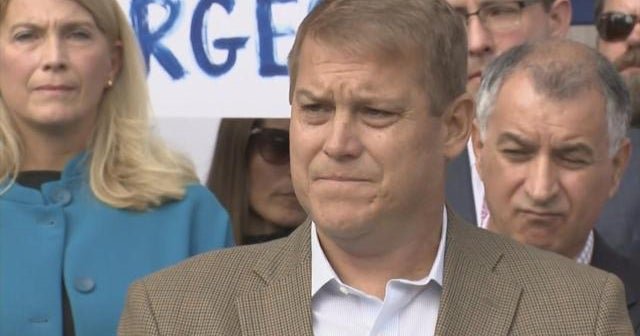[ad_1]
The Republican-backed tax and spending bill that’s now moving forward in the House is getting a reality check from Wall Street. That’s because the proposed tax breaks are projected to far outstrip any savings in the bill, potentially leading to mounting U.S. debt and a worsening fiscal outlook, according to economists and policy experts.
If the bill moves forward without significant changes, the U.S. would likely find its debt levels spiraling higher in order to finance the tax cuts, according to several analyses. Over the next decade, the GOP bill could cost the U.S. $3.8 trillion, according to a report earlier this month by the Joint Committee on Taxation that examined the impact of the the tax measures versus spending cuts.
Those risks are rattling Wall Street. Moody’s Ratings on Friday downgraded the nation’s debt, citing the potential for the new bill to add $4 trillion to the federal primary deficit, which excludes interest payments, over the next decade.
The bill also faces detractors within the Republican party, with the House Freedom Caucus saying in a social media post on Sunday that the bill “fails to actually honor our promise to significantly correct the spending trajectory of the federal government and lead our nation towards a balanced budget.”
The concern, according to both Wall Street economists and policy experts, is that adding billions in debt to the U.S. ledger could eventually squeeze federal spending because the nation would likely face higher interest payments. That, in turn, could make it more difficult to fund programs like Social Security, which is already facing a financial drawdown as baby boomers hit retirement age, or to invest in initiatives like infrastructure that can spur economic growth.
“It’s time for policymakers to hit pause, go back to the drawing board and put forward a plan that actually takes steps toward putting our nation on a sustainable fiscal trajectory,” said Maya MacGuineas, president of the Committee for a Responsible Federal Budget, a public policy think tank, in an email.
She added, “Our federal interest payments are skyrocketing, already surpassing what we spend annually on defense or Medicare.”
The Trump administration said it disagreed both with the Moody’s analysis and forecasts that the legislation could widen the nation’s deficit, which is the gap between federal spending and revenue.
“This bill does not add to the deficit,” White House spokeswoman Karoline Leavitt said Monday in a press conference. “In fact, according to the Council of Economic Advisers, there’s $1.6 trillion worth of savings in this bill — that’s the largest saving for any legislation that has ever passed Capitol Hill in our nation’s history.”
Savings versus spending
At the heart of the proposed GOP bill is President Trump’s vow to renew his 2017 Tax Cuts and Jobs Act, which introduced lower tax brackets for many Americans. Because those provisions are set to expire at the end of 2025, about 6 in 10 filers would face a tax increase in 2026 without an extension of the law, according to an analysis from the nonpartisan Tax Foundation.
The Council of Economic Advisers, a White House agency that advises the president on economic issues, said in a May study that the new bill would “avert a $4 trillion tax hike” by extending the TCJA’s provisions.
Renewing the law’s cuts alone would cost $2.2 trillion over the next decade, estimates Joint Committee on Taxation, which assesses the impact of policy for Congress. The GOP bill also includes other new tax breaks that would add to the bill’s long-term costs, the group’s analysis found.
For instance, the bill’s proposal to provide taxpayers with a more generous standard deduction would result in $1.3 trillion in lost revenue over the next decade, the Joint Committee found. Eliminating taxes on workers’ overtime pay and tips, as well as giving a bigger deduction to senior citizens, would cost an additional $234 billion over the same period, its analysis finds.
The bill does include spending cuts, but they aren’t large enough to offset the tax breaks, several recent analyses conclude. The nonpartisan Bipartisan Policy Center estimatedin a May 14 analysis that the tax cuts would cost $7.7 trillion over the next decade, while the spending cuts would offset $3.9 trillion over the same period. The result is a gap of $3.8 trillion, it said.
That’s the arithmetic that prompted Moody’s to cut its rating on U.S. debt, from its top rating of Aaa to Aa1. In its assessment, the credit rating agency noted that the U.S. deficit has spiraled higher as previous administrations and Congress have “failed to agree on measures to reverse the trend.”
“Over the next decade, we expect larger deficits as entitlement spending rises while government revenue remains broadly flat,” Moody’s said on Friday when it became the third major rating agency to cut the nation’s credit rating. “In turn, persistent, large fiscal deficits will drive the government’s debt and interest burden higher.”
It added, “The U.S.’ fiscal performance is likely to deteriorate relative to its own past and compared to other highly rated sovereigns.”
The Trump administration says that the proposed tax bill will spur economic growth by lowering taxes on consumers and businesses. In an interview on Monday with Fox Business, National Economic Council director Kevin Hassett said the economy is “going to continue to take off once those policies are actually in place, once we actually have the tax cuts passed.”
Who wins and loses
The GOP tax bill remains in flux and is likely to change as it winds through the House.
House Speaker Mike Johnson acknowledged there are still details to “iron out” as conservative Republicans seek to quickly enact work requirements for able-bodied participants in Medicaid. Those rules would take effect in 2029 under the bill passed last week by the Ways and Means Committee. Some House Republicans also want to more quickly end tax breaks for green energy projects being used nationwide.
If the bill passes the House this week, it would then move to the Senate, where Republicans are also eyeing changes.
Democrats have decried the cuts Republicans are proposing to Medicaid and food stamps to offset the costs of the tax breaks, pointing out that the reductions in social safety net programs comes as many wealthy taxpayers would get a big tax break.
“This spending bill is terrible, and I think the American people know that,” Rep. Jim Clyburn, a Democrat from South Carolina, told CNN’s “State of the Union″ on Sunday. “There is nothing wrong with us bringing the government in balance. But there is a problem when that balance comes on the back of working men and women. And that’s what is happening here.”
The lowest-income Americans would end up paying more under the proposed GOP bill, according to a May 19 analysis from the Penn Wharton Budget Model, a University of Pennsylvania group that studies the fiscal impact of public policies. Even including savings from tax cuts, the bottom 20%, who earn up to $17,000 per year, would take a $1,035 hit in 2026 after the reductions in Medicaid and other programs are factored in.
“[H]ouseholds most affected by the cuts to Medicaid and SNAP — those in the bottom income quintile — experience the largest losses under this bill, averaging $28,000 in lifetime value for the working-age population,” the Penn Wharton Budget model calculated. “In contrast, working-age households in the top income quintile generally benefit from lower taxes, gaining an average of $30,000.”
contributed to this report.
[ad_2]



